Phytochemicals and botanical extracts regulate NF-κB and Nrf2/ARE reporter activities in DI TNC1 astrocytes
- PMID: 27166148
- PMCID: PMC4900906
- DOI: 10.1016/j.neuint.2016.05.004
Phytochemicals and botanical extracts regulate NF-κB and Nrf2/ARE reporter activities in DI TNC1 astrocytes
Abstract
The increase in oxidative stress and inflammatory responses associated with neurodegenerative diseases has drawn considerable attention towards understanding the transcriptional signaling pathways involving NF-κB (nuclear factor kappa-light-chain-enhancer of activated B cells) and Nrf2 (Nuclear Factor Erythroid 2-like 2). Our recent studies with immortalized murine microglial cells (BV-2) demonstrated effects of botanical polyphenols to inhibit lipopolysaccharide (LPS)-induced nitric oxide (NO) and enhance Nrf2-mediated antioxidant responses (Sun et al., 2015). In this study, an immortalized rat astrocyte (DI TNC1) cell line expressing a luciferase reporter driven by the NF-κB or the Nrf2/Antioxidant Response Element (ARE) promoter was used to assess regulation of these two pathways by phytochemicals such as quercetin, rutin, cyanidin, cyanidin-3-O-glucoside, as well as botanical extracts from Withania somnifera (Ashwagandha), Sutherlandia frutescens (Sutherlandia) and Euterpe oleracea (Açaí). Quercetin effectively inhibited LPS-induced NF-κB reporter activity and stimulated Nrf2/ARE reporter activity in DI TNC1 astrocytes. Cyanidin and the glycosides showed similar effects but only at much higher concentrations. All three botanical extracts effectively inhibited LPS-induced NF-κB reporter activity. These extracts were capable of enhancing ARE activity by themselves and further enhanced ARE activity in the presence of LPS. Quercetin and botanical extracts induced Nrf2 and HO-1 protein expression. Interestingly, Ashwagandha extract was more active in inducing Nrf2 and HO-1 expression in DI TNC1 astrocytes as compared to Sutherlandia and Açaí extracts. In summary, this study demonstrated NF-kB and Nrf2/ARE promoter activities in DI TNC1 astrocytes, and further showed differences in ability for specific botanical polyphenols and extracts to down-regulate LPS-induced NF-kB and up-regulate the NRF2/ARE activities in these cells.
Keywords: ARE reporter; Ashwagandha; Açaí; NF-κB reporter; Quercetin; Sutherlandia.
Copyright © 2016 Elsevier Ltd. All rights reserved.
Figures
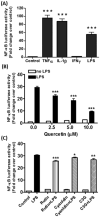
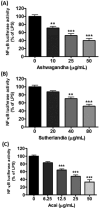
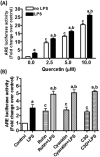
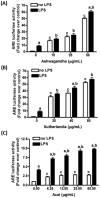
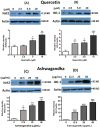

Similar articles
-
Withania somnifera and Its Withanolides Attenuate Oxidative and Inflammatory Responses and Up-Regulate Antioxidant Responses in BV-2 Microglial Cells.Neuromolecular Med. 2016 Sep;18(3):241-52. doi: 10.1007/s12017-016-8411-0. Epub 2016 May 21. Neuromolecular Med. 2016. PMID: 27209361
-
Anti-inflammatory effects of astroglial α7 nicotinic acetylcholine receptors are mediated by inhibition of the NF-κB pathway and activation of the Nrf2 pathway.J Neuroinflammation. 2017 Sep 26;14(1):192. doi: 10.1186/s12974-017-0967-6. J Neuroinflammation. 2017. PMID: 28950908 Free PMC article.
-
Quercetin inhibits lipopolysaccharide-induced nitric oxide production in BV2 microglial cells by suppressing the NF-κB pathway and activating the Nrf2-dependent HO-1 pathway.Int Immunopharmacol. 2013 Nov;17(3):808-13. doi: 10.1016/j.intimp.2013.09.009. Epub 2013 Sep 25. Int Immunopharmacol. 2013. PMID: 24076371
-
Dissecting molecular cross-talk between Nrf2 and NF-κB response pathways.Biochem Soc Trans. 2015 Aug;43(4):621-6. doi: 10.1042/BST20150014. Epub 2015 Aug 3. Biochem Soc Trans. 2015. PMID: 26551702 Free PMC article. Review.
-
Modulation of Nrf2 and NF-κB Signaling Pathways by Naturally Occurring Compounds in Relation to Cancer Prevention and Therapy. Are Combinations Better Than Single Compounds?Int J Mol Sci. 2021 Jul 30;22(15):8223. doi: 10.3390/ijms22158223. Int J Mol Sci. 2021. PMID: 34360990 Free PMC article. Review.
Cited by
-
Polyphenols in the Central Nervous System: Cellular Effects and Liposomal Delivery Approaches.Int J Mol Sci. 2025 Jul 4;26(13):6477. doi: 10.3390/ijms26136477. Int J Mol Sci. 2025. PMID: 40650253 Free PMC article. Review.
-
Regenerative Wound Dressings for Skin Cancer.Cancers (Basel). 2020 Oct 13;12(10):2954. doi: 10.3390/cancers12102954. Cancers (Basel). 2020. PMID: 33066077 Free PMC article. Review.
-
Docosahexaenoic acid (DHA): An essential nutrient and a nutraceutical for brain health and diseases.Prostaglandins Leukot Essent Fatty Acids. 2018 Sep;136:3-13. doi: 10.1016/j.plefa.2017.03.006. Epub 2017 Mar 10. Prostaglandins Leukot Essent Fatty Acids. 2018. PMID: 28314621 Free PMC article. Review.
-
What We Know about Euterpe Genus and Neuroprotection: A Scoping Review.Nutrients. 2023 Jul 19;15(14):3189. doi: 10.3390/nu15143189. Nutrients. 2023. PMID: 37513607 Free PMC article.
-
The Role of the Nrf2/ARE Antioxidant System in Preventing Cardiovascular Diseases.Diseases. 2016 Nov 11;4(4):34. doi: 10.3390/diseases4040034. Diseases. 2016. PMID: 28933413 Free PMC article. Review.
References
-
- Abraham NG, Kappas A. Pharmacological and clinical aspects of heme oxygenase. Pharmacol Rev. 2008;60:79–127. - PubMed
-
- Cardozo LF, Pedruzzi LM, Stenvinkel P, Stockler-Pinto MB, Daleprane JB, Leite M, Jr, Mafra D. Nutritional strategies to modulate inflammation and oxidative stress pathways via activation of the master antioxidant switch Nrf2. Biochimie. 2013;95:1525–1533. - PubMed
-
- Chen JC, Ho FM, Pei-Dawn Lee C, Chen CP, Jeng KC, Hsu HB, Lee ST, Wen Tung W, Lin WW. Inhibition of iNOS gene expression by quercetin is mediated by the inhibition of IkappaB kinase, nuclear factor-kappa B and STAT1, and depends on heme oxygenase-1 induction in mouse BV-2 microglia. Eur J Pharmacol. 2005;521:9–20. - PubMed
Publication types
MeSH terms
Substances
Grants and funding
LinkOut - more resources
Full Text Sources
Other Literature Sources

